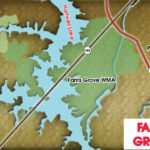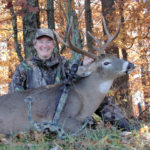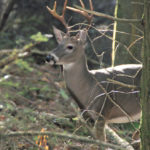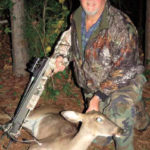
Try these sniper tactics for certain success on your next public-land hunt.
The scene could have been taken directly from a 1980s Vietnam-era war movie, only in this case, the unsuspecting victim wasn’t a soldier, but a respectable 8-point whitetail buck, and the backdrop was the shoreline of Lake Hartwell, not the Mekong Delta.
The buck picked its way along a trail, pausing briefly as the noise of an outboard motor droned by nearly a quarter-mile away. The buck paid little attention, just as one of his inland brethren would ignore the noise of a vehicle on a rural upstate highway.
Switch to a closeup of a hunter. Only 40 yards away, he’s keenly aware of the buck’s presence but doesn’t move a muscle. Weapon at the ready, only his eyes, peering from behind a full-face mask, follow the deer as it steps closer to the obscure shooting lane prepared months earlier. He glances back and forth from the deer to the opening, 20 yards to his left in middle of a cluster of white oaks — only a few steps ahead of the buck.
Sniffing the cooling lake wind and the smell of fresh mast on the ground, the buck relaxes. Letting his guard down, he begins crunching acorns, unaware he’s broadside in the shooting lane.
A muted, metallic clank signals the release of an arrow from the hunter’s crossbow, and the razor-sharp broadhead finds its mark before the buck’s ears even register the sound. The deer bolts into the surrounding forest but falls only a few steps from where it was shot. The hunter materializes from his makeshift blind and makes preparations to collect his prey.
When he’s not playing the part of Rambo in the deer woods, Bill Plumley, a retired Mitsubishi employee turned fishing guide, lives in Townville. When considering his retirement plans, Plumley had two goals: he wanted to be closer to the lake and closer to where he could hunt. A lifelong bowhunter, he recognized the potential of the public land in the vicinity of Lake Hartwell. When he recognized the lake also held an untapped resource of his other passion, blue and channel catfish, he was sold.
“I’ve hunted (on) leased club lands in Spartanburg and Laurens counties my whole life,” he said. “I had to drive an hour or more from my house when I lived in Greer. When I decided to set up my fishing business on Lake Hartwell four years ago, I discovered all the land that surrounded the lake. Between Fant’s Grove, the Keowee Unit, and all the (U.S. Army Corps of Engineers) land, I figured there was nearly 15,000 acres right outside my door.”
The change in location caused Plumley to change his hunting style. Since permanent stands are not allowed on these public lands, and since he wasn’t keen on using climbing stands in his later years, Plumley taught himself how to hunt from the ground.
“Most archers wouldn’t dream of hunting off the ground,” he said. “It’s tough enough to get that close to a deer and get drawn on him from high in a tree, much less a ground blind. Plus, I like to hunt thick areas near clearcuts and on lake-point ridges. A lot of these areas don’t have substantial trees close enough to where I wanted to hunt. Hunting from the ground just seemed to make the most sense.”
According to Plumley, three major keys combine to make for successful hunting from the ground. The first is a zero tolerance of error in playing the wind.
“It can be tough because you may have a consistent wind higher up, but down on the lake, the wind tends to swirl more,” he said. “I soon discovered that when hunting on the ground, if the wind changed directions, I can relocate to a favorable spot in less than a minute.”
Plumley spends a great deal of time during the offseason both scouting and creating ground blinds in his hunting areas. His blinds are simple, requiring only a solid backstop to break up his outline and a few limbs to brush himself in. Most other hunters wouldn’t recognize his blinds if they were standing in them.
“Shooting lanes are also important,” he said. “I create two lanes for each blind, one main lane straight ahead and one to my left so I don’t have to move to make a right handed shot. My shooting lanes are more like paths clear of limbs and vines rather than an obviously manicured lane. I build a blind at each end of the lane, so if the wind swaps, I can pick up my folding chair and move to the other end quickly.”
The final step was personal camo. He didn’t like flat camo clothing, so he asked his wife to design and make him a 3-dimensional ghillie suit, which she did, even making him a fleece backpack when he couldn’t find one quiet enough to suit him. After planning his retirement for a couple of years, the government provided Plumley with another retirement gift.
“(South Carolina) legalized crossbows,” he said. “Actually, the legal definition of archery was changed to include crossbows as archery gear. I’ve hunted with compound bows and longbows for 30 years and I’ve found it’s just as challenging to hunt with a crossbow. The benefit for me is when I’m nose-to-nose on the ground with a deer, I don’t have to draw right before I take a shot.”
Crossbow hunting has enjoyed varying popularity across the country for years but has mushroomed in recent years as many states have taken steps to open doors for crossbow hunters. Initially, the move was met with some resistance from the archery community, which viewed crossbows as superior weapons with extended ranges and faster speeds but requiring less skill.
Experience has proven different.
Barb Terry of TenPoint Technologies agrees with Plumley’s sentiments that deer hunting with a crossbow is every bit as challenging as using traditional archery gear.
“We have done side-by-side comparisons between our crossbows and some of the industry leaders in vertical archery gear,” Terry said. “In these tests, we have shown that crossbow arrows will drop faster than other arrows because they are generally shorter and heavier than those used with vertical archery.”
Terry recommends that hunters limit their shooting range to 40 yards in order to make effective, ethical kills, especially with crossbows. She also said that many hunters who’ve never tried any type of archery gear and buy a crossbow just to extend their deer season are in for a rude awakening.
“The close proximity required to kill a deer with a crossbow spooks a lot of gun hunters,” she said. “Scent control is still paramount, as well as playing the wind, estimating distances, and shot placement. A lot of hunters get discouraged because they think it’s a far superior weapon. It’s not as easy as it’s made out to be, hunting with a crossbow requires the same skills. It’s just one more way to get out in the woods and enjoy what we all enjoy doing.”










Be the first to comment